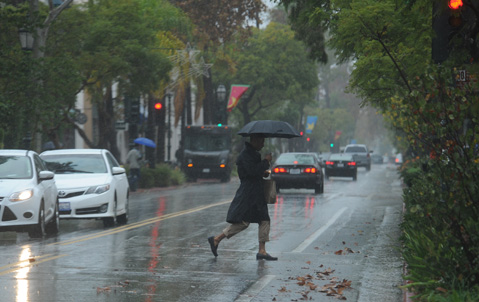Rain, Rain, Don’t Go Away
This Week's Drenching Provides Only Small Relief from Drought

The wettest weather since March descended on the South Coast this week. As of Wednesday morning, rainfall totals — tracked by the county’s Public Works Department — measured close to two inches and in many places surpassed that. San Marcos Pass clocked 4.3 inches in a two-day period, Gaviota scored 3.25 inches, and the Ellwood area received 2.75 inches. More than 2 inches of rain soaked UCSB, the downtown County Administration Building, and Montecito.
The National Weather Service, which issued several rain- and wind-related advisories ahead of the storm, predicted one to two inches for coastal areas and two to five inches for the mountain regions across Southern California, including Santa Barbara County. While the first few days of the week brought substantial sogginess, the agency forecasted cloudy but dry conditions going into the weekend.
The Santa Barbara area last got significantly saturated on Halloween, when rain gauges measured between 0.75 and 1.6 inches across the county. But this week’s storm came close to rivaling the one that hit the region in late February and early March. During that four-day period, 5.7 inches of rain fell in downtown Santa Barbara, according to County Public Works.
The deluge prompted the county’s Environmental Health Services to issue a warning about storm-water runoff making its way into waterways and the ocean, as contact with the water could increase the likelihood of fever, chills, ear infections, vomiting, and diarrhea. Swimmers and surfers were warned against entering the waterways for at least three days after the storm, and shellfish fishermen were cautioned against harvesting for at least 10 days to prevent shellfish-bed contamination.
Although welcome, the drenching won’t mean instant help for the drought conditions, said county water czar Tom Fayram. Multiple, successive storms — and 10-15 inches over the season — are what’s needed for improved runoff levels, Fayram said, adding that Lake Cachuma, currently about one-fourth its capacity at 55,000 acre-feet, could come up a couple of inches. “It’s not going to help in terms of the drought immediately,” Fayram said. “We definitely need it. You have to start somewhere.”


